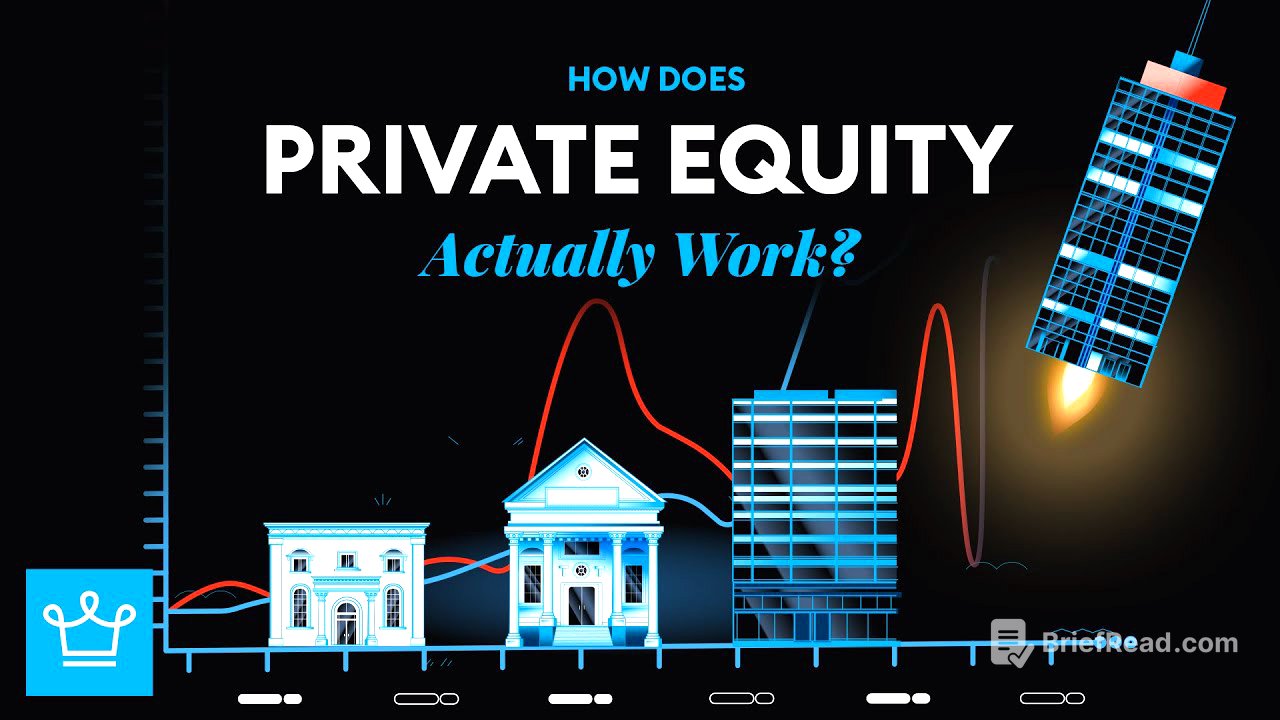TLDR;
This video explains private equity, detailing its history, strategies, and how it generates wealth. It covers the evolution of private equity from early business tycoons to modern firms, highlighting key strategies like leveraged buyouts (LBOs), growth equity, and distressed investing. The video also discusses how private equity firms generate income through fees, strategic exits, and debt management, illustrating both successful and unsuccessful deals.
- Private equity involves buying companies, improving them, and selling for profit.
- Key strategies include leveraged buyouts, growth equity, and distressed investing.
- Firms generate income through management fees, performance fees, and strategic exits.
Introduction to Private Equity [0:00]
Private equity is a method used by large investors to acquire companies, enhance their performance, and then sell them for a profit. This approach involves a four-step process: raising funds from outside investors, using these funds to purchase companies, restructuring the acquired companies to boost profitability through measures like new leadership or operational improvements, and finally, selling the companies after about 5 to 10 years via IPOs, sales to other companies, or to other private equity firms. The goal is to sell the company for significantly more than the purchase price, generating substantial profits for the firm and its investors.
The History and Evolution of Private Equity [2:14]
In the early 1900s, tycoons like JP Morgan, the Rockefellers, and the Vanderbilts were making deals using investor money to buy companies, but instead of flipping them, they merged them into massive corporations to build empires. After World War II, George Doy, a Harvard professor, created the American Research and Development Corporation (ARDC) in 1946, the first venture capital firm. ARDC's investment of $70,000 in Digital Equipment Corporation (DEC) turned into $355 million when DEC went public in 1968. By the 1980s, private equity shifted from betting on new ideas to restructuring existing companies for profit. In the 1990s and early 2000s, pension funds, university endowments, and governments started investing in private equity. Post-2008, regulations tightened, leading firms to focus on improving operations and using technology to increase profits. By the 2010s, private equity firms like Blackstone, Carlyle, and Apollo managed trillions of dollars, influencing various industries.
Leveraged Buyouts (LBOs) [5:17]
A leveraged buyout (LBO) involves acquiring a company using funds from investors and significant borrowing, leveraging the target company's assets to secure the debt. For example, in 2007, Blackstone Group acquired Hilton Hotels for $26 billion, appointed a new CEO, shifted the company's focus to brand management and franchising, and invested $800 million to boost financial health. When Hilton went public again in 2013, Blackstone gradually sold its stake, making around $14 billion in profit over 11 years. However, not all LBOs are successful. The 2005 acquisition of Toys R Us by private equity firms for $6.6 billion, financed with debt placed on the company's balance sheet, led to its bankruptcy in 2017 due to a lack of investment and the burden of debt and fees.
Growth Equity and Venture Capital [9:15]
Growth equity involves investing in established, fast-growing businesses to help them expand, scale operations, enter new markets, or develop new products. These deals use little to no debt, and private equity firms usually buy a minority stake. For instance, General Atlantic and KKR invested in ByteDance, the parent company of TikTok, providing the funds to scale its operations quickly. Venture capital, on the other hand, involves investing in small, unproven startups with the hope of high returns. Firms like Sequoia and Andreessen Horowitz have invested in successful companies like Airbnb, Google, WhatsApp, Skype, Facebook, and Twitter. However, venture capital is high-risk, as illustrated by Sequoia's $214 million loss in the cryptocurrency exchange FTX and the $700 million loss in Theranos.
Distressed Investing [11:26]
Distressed investing involves buying struggling or bankrupt companies at a discount and attempting to turn them around for profit. Sometimes this means fixing operations and making the company profitable again, like when OpCapita bought Game UK and significantly increased its market value. However, other times, firms cut costs so aggressively that they leave the company worse off than before. An early example is Victor Posner's hostile takeover of Sharon Steel in 1969, which led to the company's bankruptcy in 1987. Despite the risks, private equity has created billionaires and built significant financial empires.
How Private Equity Firms Generate Wealth [12:50]
Private equity firms generate wealth through multiple income streams. They charge investors management fees (usually 2% of total assets) and performance fees (20% of profits). Their exit strategies aim for maximum profit, considering IPOs, sales to competitors, or flipping to other firms. The acquired company pays the loan, and the interest is tax-deductible, allowing the business to keep more earnings. Since the firm contributes only a fraction of the purchase price, their return on investment can be substantial. This model has led to the creation of firms like Blackstone, KKR, and Apollo, which manage trillions of dollars and own diverse assets.









